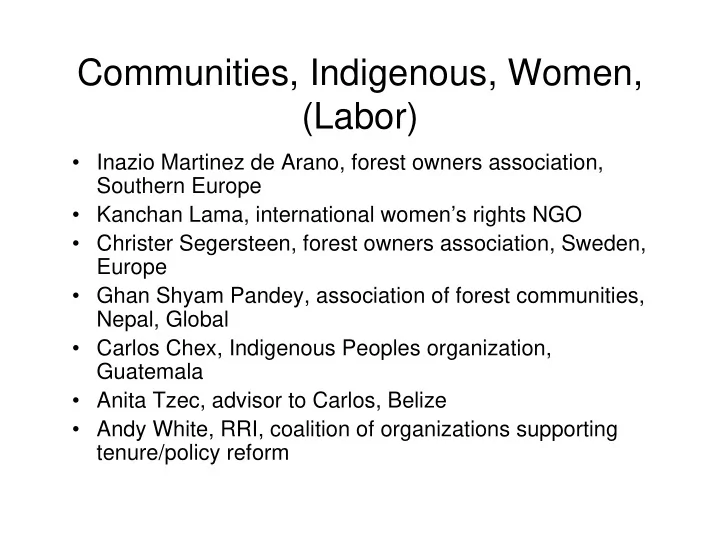

Communities, Indigenous, Women, (Labor) • Inazio Martinez de Arano, forest owners association, Southern Europe • Kanchan Lama, international women’s rights NGO • Christer Segersteen, forest owners association, Sweden, Europe • Ghan Shyam Pandey, association of forest communities, Nepal, Global • Carlos Chex, Indigenous Peoples organization, Guatemala • Anita Tzec, advisor to Carlos, Belize • Andy White, RRI, coalition of organizations supporting tenure/policy reform
Background Issues/Principles • Communities, households, farmers have been investing their own resources in forest protection, management, and restoration for many years – and thus should not be the losers – and see major risk of others, deforesters, being rewarded under REDD – issue of fairness; • Indigenous and other communities, small forest owners, are now responsible for major protection of forest AND restoration – not the major source of emission. (most emissions now from government lands, in countries that have not recognized indigenous and household land rights, not from indigenous or household forest); • Sometimes land rights recognized, but often rights to use/manage not given – so lots of obligations and responsibilities, and growing tendency to reduce and restrict use rights (zoning, regulations) and major risk that REDD could increase this; • For IP, households, women: property rights are part of their human rights – and recognition of these are an obligation of governments– not negotiable; – And: use of these forests is also part of their rights and again great risk of REDD reducing/controlling these rights.
Scope of Activities (to Finance) – Traditional management that exist among the indigenous communities should be financed (they do forest management not only for livelihood but also for cultural preservation and maintain traditional values) – SFM: (using mitigation funds to finance management helps legitimize these activities – thereby helping secure tenure rights to land and to carbon, and encourage tenure reform – Maintaining existing stocks – Production of wood products, fuelwood: products that substitute for fossil fuels/non-renewable energy – giving more incentive for forest management/restoration – Afforestation as an activity and CDM as a tool – Recognizing and clarifying land, resource, carbon rights (i.e. tenure reform is a mitigation activity) – Capacity building of rural women, men and indigenous local communities, as well as governments
Ensuring “Appropriate” Access to Finance • Establish explicit criteria for country eligibility: – Fair distribution of benefits – Recognition of rights (including land and carbon ownership, and right to say “no”, women’s rights) – Commitment to fair representation in national planning and decision making, “oversight”, transparency with information, – Commitment to free, fair, access of communities, landowners to markets for their commodities; – Commitment to capacity building at levels ,-from the community level to the national level • However: the requirements are contextual and may not be similar in all contexts; need to have appropriate mechanisms for all different contexts
Revenue Generation • How? Both funds and markets; all different mechanisms-different approaches for different activities • Mechanisms? CDM, taxes on carbon trade; carbon tax, PES by private sector, governments to landowners; biodiversity/ecosystem “offsets”;
Disbursement • Prefer project approach: benefits to landowners, to strengthen the existing indigenous, community initiatives to protect and promote indigenous products • Both types of approach, local, national and global level projects/programs • Prefer fragmented and decentralized as much as possible, (prefer payments to landowners) • Centralized systems depending on the activity
Sharing of Benefits • Privilege landowners who have conserved, are conserving and restoring; (i.e. don’t pay the deforesters) • Work to establish gender responsive laws and regulations for enabling women to equal benefit sharing (i.e. take advantage of carbon payments to reform laws, strengthen women’s ownership rights, set precedents for gender equity)
Effective Participaiton (Oversight) General Principles: • Ensure participation of women as well as men (in policy making, program implementation, oversight), as well as IP • Communities, landowners, should have clear right to decide whether or not, they (and their land and carbon) participate in national programs;
Participation (Oversight) Mechanisms (to be set up during “Readiness): • Ensure that every national program have a Framework of Participation (FOP), to ensure fair and adequate representation of IP in decision- making, women, landowners, in the design and implementation of carbon program • Oversight mechanism: At national level, there should be an independent oversight committee with inclusive representation of stakeholders – with full access to all information and full authority to review, audit, process complaints,
Other Issues? • In all of this effort on climate change: don’t forget human rights and women’s rights – potential for conflict if seen as unfair; • Critical need to clarify and make well known that carbon is owned by the owner of the tree and the land – can’t be taken by the government. Most legal frameworks still unclear on this. • Must have a mechanism to rewarding existing carbon stocks – or they might be lost; • Critical need to increase the dissemination of information about REDD (and related options and instruments) to communities, to ensure “level playing field”
Recommend
More recommend